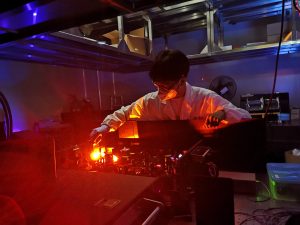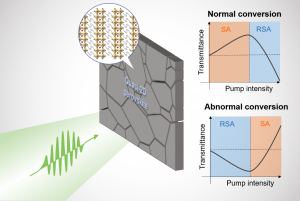Wang Gang, a PhD student in the Institute of Applied Physics and Materials Engineering (IAPME), University of Macau (UM), has discovered an abnormal nonlinear optics conversion in quasi-2D perovskite materials, which is a breakthrough in understanding the nonlinear optical absorption of low-dimensional semiconductors and will pave the way for the development of novel nonlinear optical devices such as all-optical switches and pulsed laser. The research results have been published in the internationally-renowned journal Nature Communications
In the field of nonlinear optics, saturable absorption (SA) and reverse-saturable absorption (RSA) are two important light intensity modulation tools that have been used for purposes such as ultrafast laser pulse generation, all-optical switching, laser protection, and bioimaging. Under certain conditions, SA and RSA can coexist, which will result in a shift from SA to RSA as the nonlinear absorption response of the material increases with light intensity, according to the conventional standard nonlinear absorption model. However, in this study of quasi-2D perovskite materials, this inherent knowledge was challenged. In the past few years, owning to the remarkable optoelectronic properties of hybrid perovskites, studies of such materials have achieved outstanding results in various fields, spanning from photovoltaics to light emission devices. Meanwhile, the strong light-matter interaction in perovskites gives them remarkable nonlinear optical properties. This is particularly evident in a new type of low-dimensional perovskite materials. The strong excitonic effect not only enhances the intensity of nonlinear response, but also gives rise to novel nonlinear optical properties.
In this study, the researchers discovered an unusual RSA to SA conversion in (PEA) 2FAPb2I7 quasi-2D perovskite materials as the intensity of the excitation increased. The result, which completely contradicts with the conventional theory of nonlinear absorption, has drawn the attention of the research team. Using ultrafast transient absorption spectroscopy, the researchers found that such abnormal nonlinear absorption is the result of the competition between broadband absorption enhancement caused by multibody interactions and absorption bleaching caused by non-thermalised carriers. The ultrafast transient absorption singularity from non-thermalised ‘Fermi Sea’ was firstly observed in the quasi-2D perovskite system. Moreover, a comparative study between 2D and 3D perovskites uncovered the crucial role of hot-carrier effects to tune the nonlinear absorption response. The study showed that ultrafast carrier cooling of quasi-2D perovskite is the key to the abnormal nonlinear absorption switching process. By tuning the dimensionality and composition of the perovskite materials, the researchers have achieved pure RSA, RSA-SA conversion, and pure SA response respectively, which demonstrated the flexible non-linear optical response of the materials. Titled ‘Hot-carrier Tunable Abnormal Nonlinear Absorption Conversion in Quasi-2D Perovskite’, the paper highlighting this research result has been published in the internationally-renowned multidisciplinary journal Nature Communications.
Xing Guichuan, professor in the IAPME, is the lead corresponding author of this study and the first author is Wang. This project was funded by the Science and Technology Development Fund of Macao SAR (File no: FDCT-0044/2020/A1, 0082/2021/A2) and UM (MYRG2020-00151-IAPME).
To view the full version of the paper, please visit: https://www.nature.com/articles/s41467-022-34705-8
| Source: Institute of Applied Physics and Materials Engineering | |
| Media Contact Information: | |
| Communications Office, University of Macau | |
| Albee Lei | Tel: (853) 8822 8004 |
| Cathy Cheang | Tel: (853) 8822 8009 |
| Email: | prs.media@um.edu.mo |


